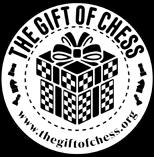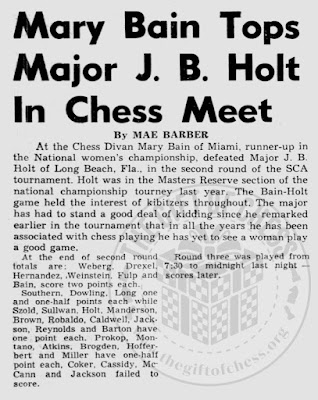Back to Home Index
January 16 1949
Tampa Bay Times, St. Petersburg, Florida, Sunday, January 16, 1949
Mary Bain's Play Thrills Chess Fans
By DR. A. B. FERGUSON
Mary Bain of Miami gave one of the finest exhibitions of chess last Saturday night ever held in the St. Petersburg Chess Club. Her splendid blindfold demonstration of Knight's Tour revealed a remarkable memory and her prowess in chess was shown in her record of fifteen wins, three draws and only four losses when she played eighteen men and six women over the board. She conceded wins to Sigmund Bergmann, W. J. Dixon, Herman Voges, and F. J. Zipf, drew with Henrietta Argenbright, Robert Warriner and Dr. Isadore Scheinberg. She defeated Ludwig Dobesh, W. W. Werner, R. J. Conley, Paul and Mrs. Demokes, Sara Lyndon, George Thompson, John McCann, Mildred Thomis, Else Binetsch, Bernard Harris, Anne Cassidy, J. H. Dion, G. Kaltner and Nathan Barbash.
Karl Ginter of Charlottesville, N. C. is another member who flies to the club whenever business is slack. Born in Lodz, Poland, he received his early education in the Gymnasia of that city majoring in chemistry. After graduation he became an apprentice in a dye works in Lodz in which his father was business manager. This was followed by apprenticeships in dye stuffs and dyeing materials in Zurich and Basel, Switzerland and in Germany. Later in Copenhagen Denmark, Ginter was manager of the dyeing department of Hanibel Sanders Company. In 1920 he came to New York City and was employed in several dyeing establishments and later formed his own company there. “The Industrial Dyeing Corporation of America,” with plants also in Pawtucket, R. I. and Charlottesville, N. C. dyeing everything from tapestries to thread.
Karl learned chess, at twelve years of age, taught by his father. For twenty-five years he was a member of The Manhattan Chess Club of New York City and for three years has been coming to St. Petersburg because of “chess, golf and the wonderful climate.”
July 24 1949
Tampa Bay Times, St. Petersburg, Florida, Sunday, July 24, 1949
Chess Divan: Bain Entered To Play Here In Tournament by Dr. A. B. Ferguson
Mrs. Mary Bain, internationally known chess player, will be one of Miami's top players in the Florida Chess League Tournament to be held here September 3-5.
Mary Bain, while attending high school in her native Hungary, found chess quite popular among the pupils and on returning to her country home, she expressed a desire to learn the game. Her mother, who had played chess in her youth, taught Mary the first moves. The latter immediately became a chess enthusiast.
Shortly after the first World War she left Hungary for her first exhibition game in America. She expected a dull and lonely ocean trip because although he spoke Rumanian, German and Ukrainian fluently, she knew no English. When on the first day out the steward passed out games. Mrs. Bain asked for a chess set, planning to amuse herself with the game. Apparently the passenger list was filled with chess players and the next day a German-speaking acquaintance and the ship's captain made a date with her for a game in the evening. When she arrived in the salon, many passengers were gathered to watch the match. It was Mary Bain's first exhibition game and she won.
Here in America she attended schools to learn the English language. She eventually married, reared two children and kept up her interest in chess.
In 1939 she finished in a three way tie, in 1945 third position in the Women's National Championship tournaments. Two years ago she won first prize in the women's group of the Southern Chess Association tournament held here.
Mary Bain is no stranger to the St. Petersburg Chess Club having given two simultaneous chess exhibitions here with remarkable records. She writes: “Since the Florida chess league tournament is going to be held in your club (my favorite spot) I'll be more than glad to enter.”
August 14 1949
Hartford Courant, Hartford, Connecticut, Sunday, August 14, 1949
Connecticut Chess
By G. E. Avery
Women's Chess Club.
In 1906 the Women's Chess Club of New York sponsored the first American Women's Chess Congress, held at the Martha Washington. Men's organizations helped greatly by providing encouragement and financial backing. Professor Isaac L. Rice, for whom a club and a gambit have been named, acted as president of the Congress, with Miss Foot as vice-president.
Years ago the club's roster listed “foreign honorary members,” with whom the members played by mail. Today, Mrs. Leslie Bain, who moved to Miami, Florida in 1942, is the only honorary member.
While living in New York, Mary Bain gave an exhibition each year at the first meeting of the club season, playing eight or 10 other members at one time. She also played blindfold. Once, at the Modern Chess Club, Mrs. Bain played 19 men simultaneously, winning 12 games, losing five and drawing two. She is one of the seeded players in Marshall tournaments.
Mary Bain was the first woman in this country to take part in the International Chess Tournament. Sent by the National Federation to compete in the 1937 event held in Stockholm, Mrs. Bain was one of 27 women players from as many nations. From there she went to England to participate in the Centenary Congress of the Worcester Chess Club. In the main event she won first prize over many men as well as women competitors.
Another outstanding member of the Women's Chess Club of New York is Mrs. William J. Seaman of Staten Island. Marjory Seaman is a sister of the Hartford architect, Cortlandt Luce. She held the championship of the club for 11 years, and was their president during most of that time. She holds the distinction of being the first victor of a Marshall Club match for women (1934). For years she was the only woman member of the Staten Island Chess Club, played on the organization's team, and in their tournaments had to give handicaps to some of the men.
Three years ago she organized a chess class among the boys on Emerson Hill, where she lives, teaching 10 boys from eight to 18, who voluntarily give up every Saturday morning for the game. Some are already opponents to be reckoned with, as outstanding players from men's clubs have discovered. Mrs. Seaman taught one of these boys the rudiments of chess while he lay in a plaster cast, flat on his back. She also plays with disabled veterans in two hospitals.
The present officers of the Women's Chess Club of New York are Mrs. James S. Cobb, president; Mrs. Alexander James Harper, vice-president and a former president; Miss Helen A. Ranlett, a lawyer, treasurer; Miss Elizabeth Wray, secretary.
Miss Wray is the current champion of the club, and a member of the Marshall. She played in the finals of the National Women's Tournament this spring. One of the strongest players of the club is Miss Amabel Mayo-Smith, great-granddaughter of Noah Webster. In one corner of her living room is a replica of Noah's West Hartford statue.
Other prominent members of the club are Mrs. David Willard of New York and Maryland (the Willards have many relatives in and around Hartford); Mrs. William Jamison, whose husband has charge of the moving picture department at the Museum of Modern Art; Miss Mildred Peters, whose great-grandfather, grandfather and uncle were in turn ministers at St. Michael's Church (Episcopal) for more than 100 years; Mrs. Kurt Orban, who escaped from Europe during World War I after harrowing experiences, and has lived all over the world; Mrs. Arthur Forbes of Great Neck, L. I., a former club champion, wife of a retired Army major.
There must be women in Connecticut who play chess, or would like to learn. Why not get together at the Hartford Chess Club? There is one woman member of the Greenfield Chess Club. Mrs. Lebzeltern, one in the Springfield club, Mrs. LaMontagne, who is secretary of the club, and at present only one woman member of the Hartford Chess Club, the writer of this article—Mrs. Alexander James Harper.
Game Selection.
While considering women in chess, we will give one more game played in the United States Women's Championship Tournament in 1946. By the way, received a telephone call last Sunday, asking what 0-0 meant in the game notation. If any one else needs this information, 0-0 means Castles, King side; 0-0-0 means Castles, Queen side.
Wally Henschel vs Mona May Karff
New York (1946), New York, NY USA
Indian Game: Capablanca Variation (A47) 0-1
September 04 1949
Tampa Bay Times, St. Petersburg, Florida, Sunday, September 04, 1949
Local Players Win In Opening Round of State Chess Tourney
By Dr. A. B. Ferguson
Tournament Play—Play in the State Chess Tournament got under way at the Chess Divan yesterday with the top players from all over the state competing for the title. Staff Photographer Johnnie Evans snapped this picture while the play was in progress. First table shows a match between Mrs. Mary Bain of Miami and J. F. Kaltner of St. Petersburg while at the second table Arthur Montano, left of Tampa plays Major J. B. Holt of Long Beach.
Five St. Petersburg chess players won in the opening round of the State Chess Tournament which is in progress at the Chess Divan and were in search of their second victory last night at press time.
Albert Mailhot, Dr. R. A. Carlyle, Charles Eastman, J. F. Kaltner and Col. F. D. Lynch defeated their opponents to pace the chess players into the second round of play.
Mailhot defeated Arthur Montano of Tampa, Carlyle beat Paul G. Clark of Tampa, Eastman defeated Mary Bain of Miami and Kaltner defeated Harold Brown of Tampa.
IN OTHER first round matches, R. Robaldo of Tampa defeated J. M. Atkins of St. Petersburg, J. B. Givson, of Tampa defeated W. P. Stronsta of Tampa, Steven Shave, Miami, beat J. E. Mink, Tampa, W. A. Reynolds of Tampa defeated A. V. Carbone, St. Petersburg, and Nester Hernandez of Tampa, defeated Silverio Castro of the same city.
In the second round last night, Robaldo was playing Reynolds, Mailhot was playing Shaw, Hernandez vs. Givson, Lynch vs. Carlyle, Kaltner vs. Eastman, Brown vs. Carbone, Mink vs. Diaz, Montano vs. Stromsti, Clarke vs. Atkins and Castro vs. Bain.
The played started yesterday afternoon and President J. B Gibson, Jr. of Tampa introduced Rev. H. V. Kahlenberg who offered prayer.
Gibson then addressed the players and general business and details of the tournament were discussed. Major J. B. Holt of Long Beach was appointed tournament director, assisted by W. A. Reynolds of Tampa and J. Houghteling of St. Petersburg.
ROUND three of the tournament will begin this morning at 9 o'clock and round four will be played at 3 p. m. The final two rounds will be played Monday.
The League will hold its next annual tournament over next Labor Day weekend at Orlando.
Steven Shaw was elected secretary-treasurer of the Florida State League to fill the vacancy caused by the resignation of Major Holt who finds his duties as president of the Correspondence League of America taking too much of his time.

























































